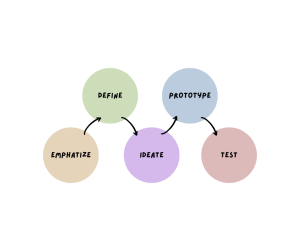Before I embarked on my career pivot to Librarianship, I had studied and worked within the design space. Most recently in UX/UI design or user experience and user interface design. In the UX/UI design process you begin with emphasizing (or research), then define the problem, ideate, prototype, test and repeat the process, reference Figure 1 below. This is an iterative process, called design thinking, that revolves around the user. I am fascinated by this process and love to contemplate how this process can be applied to other fields. I think about how we can create products and services that integrate the input of users rather than creating things just for the sake of it or for the profit of it. I am sure everyone has used a product or participated in a service and thought, why didn’t they do it this way? Well this phenomenon is the cause of things being designed without the input or thought of the end user.

Figure 1 Design Thinking
Naturally, as I’ve worked my way through SJSU’s ischool MLIS program, design thinking has been top of mind. A goal of mine has been to explore how design thinking can be applied to information organizations like libraries. I am pursuing a career in public librarianship so specifically in public libraries. In this course I’ve thought, are there other ideas or schools of thought that relate to design thinking? Is there already something in place that is comparable to this process?
In the foundational readings of this course, The Hyperlinked Library, I’ve come across participatory service and participatory libraries. “The participatory library engages and queries its entire community and seeks to integrate them into the structure of change.” (Casey, 2011). In a participatory library, users (or patrons), are integral in the creation of and development of library collections, services, resources and spaces. I have found a connection between design thinking and a participatory library, which is centering the patron. The patron is the end user, therefore they must be involved in all aspects of the library.
Why are practices like design thinking and participatory service important? “These participatory spaces are where learning will occur.” (Stephens, 2016, p. 81). By catering collections, resources and services to meet the needs of patrons, you are creating a space for them to learn. Not only will the patrons be engaged because they are involved in what is offered to them but they will feel empowered to learn and grow within that space. An example that illustrates the participatory library are positions like Teen Library Advisory Board members and Teen volunteers. By creating a platform where teens can advocate for the needs and wants of their peers, we are giving them a voice to tell the information organizations what would best serve them. Who knows better what teens need and want than teens themselves? This school of thought can be applied to all walks of life.
An (unfortunate) common phrase around libraries is that nobody uses the library anymore. When I hear this, I feel defensive of my beloved libraries, I think how can they say that? After internally reeling myself in, I think how can we meet these potential patrons where they are? “You cannot change the user, but you can transform the user experience to meet the user.” (Schneider, 2006). By creating and developing libraries that center around the patron, we can draw them in and show them all the amazing things libraries have to offer. If we transform the patron experience to an engaging one then we are meeting them where they are. “Users and their knowledge have the ability to reshape library services, but libraries must first change the way they craft their services and tools so that users have a clear and open avenue on which to communicate and participate.” (Stephens, 2019, p. 61). This semester, I’d like to explore the participatory library and delve into how libraries can meet patrons where they are.

Image from Freepik
Written by @ali0
References
Casey, M. (2011, October 20). Revisiting Participatory Service in Trying Times – a TTW Guest Post by Michael Casey. Tame The Web. Retrieved from https://tametheweb.com/2011/10/20/revisiting-participatory-service-in-trying-times-a-ttw-guest-post-by-michael-casey/
Schneider, K.G. (2006, June 3). The User Is Not Broken: A meme masquerading as a manifesto. Free Range Librarian. Retreived from https://freerangelibrarian.com/2006/06/03/the-user-is-not-broken-a-meme-masquerading-as-a-manifesto/
Stephens, M. (2016). Heart of Librarianship. American Library Association.
Stephens, M. (2019). The Wholehearted Librarian. American Library Association.
